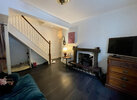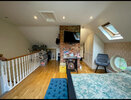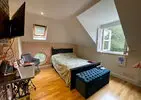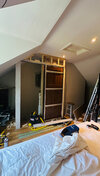Hi there
I bought a house with an existing open plan loft conservation. The house is two floors and the loft.
Bottom floor: Hallway leading to small, open plan dining room, directly next to the staircase:

You go up the stairs to the middle floor, then up the stairs again to the loft conversion:


I have now removed the bannister and added a wall and fire rated door:

As I'd understood the fire regs, I was OK because I had a fire rated door, and an unobstructed run from the loft through to the front door, but apparently, the existence of this dining room next to the staircase means I'm in breach of regs?
I have smoke detectors on every floor, and every other door in the house is fire rated.
Am I OK here, and in the event that I'm not, what are my quickest means of complying with building regs?
Thanks!
I bought a house with an existing open plan loft conservation. The house is two floors and the loft.
Bottom floor: Hallway leading to small, open plan dining room, directly next to the staircase:

You go up the stairs to the middle floor, then up the stairs again to the loft conversion:


I have now removed the bannister and added a wall and fire rated door:

As I'd understood the fire regs, I was OK because I had a fire rated door, and an unobstructed run from the loft through to the front door, but apparently, the existence of this dining room next to the staircase means I'm in breach of regs?
I have smoke detectors on every floor, and every other door in the house is fire rated.
Am I OK here, and in the event that I'm not, what are my quickest means of complying with building regs?
Thanks!

